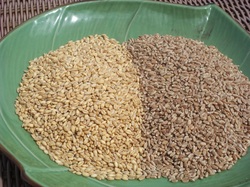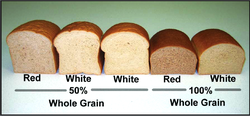
Right- Red Wheat

"50%" means that the loaf is made of 50% whole grain, and 50% all-purpose flour.
If it was, you had a gluten problem. It could be that the dough wasn't kneaded enough to form good long gluten strands, or your flour may have not had enough gluten in it to begin with. If so, use flour with a higher gluten content next time, or add gluten itself. Cans of gluten are often sold with breadbaking supplies.
Another thing that makes a big difference is how finely ground your flour is: if it's coarse, gluten can't form well. Develop enough gluten, and you have small, even air bubbles in your bread, and a chewy texture.
Why is gluten so important?
Gluten is the main protein in wheat. It forms tiny elastic chains that allow the dough to stretch and hold together, and that matrix forms walls around the carbon dioxide bubbles produced by the yeast as it grows. If there's not enough gluten, the cell walls break, leaving large, unevenly-shaped air bubbles. Gluten is activated by liquid, warmth and kneading- which is why you use as little of those three when you're making pie crust. That's one food that you want to avoid gluten forming. Gluten makes great bread, but tough pastry.
Wheat comes in different colors and 'hardness', or protein content. You can buy "soft white", "soft red", "hard white" and "hard red". There are even distinctions among the hard wheats- it is often labeled as "spring wheat" or "winter wheat". Winter wheat is planted in late fall, and grows using the moisture from winter snow and rain. Spring wheat is planted in spring, and grows through the hot, dry summer. The more water the wheat gets, the more grain it produces, but these higher yields result in lower protein content. So hard spring wheat, growing when it's hot and dry, ends up with a higher protein content. (This explanation is somewhat simplified- if you like scientific details, see here.) If you buy a bag that just says "hard red wheat", assume it's winter wheat. Being able to label wheat as "hard spring wheat" is a selling point, and the farmers get more money for higher-protein wheat.
This also means that if you buy the cheapest 'hard' wheat, you'll most likely have lower protein content. Which means it's gonna take a little more effort to make it into good bread.
Red Wheat, either hard or soft, has a deeper, heartier flavor, and a reddish-brown color.
White Wheat, hard or soft, has a more delicate flavor, and a light tan color. If you're just starting with whole-wheat bread making, this is a good one, since the flavor is more subtle. It tastes more like 'white bread', but better! I love the taste and fragrance of freshly-ground wheat in bread. Hard white wheats are relatively new to the market.
Hard Red or White Spring Wheat is usually between 12-15% protein (or gluten), the best-quality ones run between 14-15%. This is what you want for good whole-wheat bread.
Hard Red or White Winter Wheat generally contains 11- 13% protein.
Soft Red or White Wheat only has about 6-10% protein.
The protein content can be as low as 2%, or as high as 18%. It depends on growing conditions, what variety the grain is, and even how moist the wheat is. And not all the protein is gluten: only the amino acids "gliadin" and "glutenin" will become gluten. That's why oats, though high in protein, will not make good yeast bread on its own. They don't contain gliadin and glutenin as part of the amino acid profile. This is also why celiacs can have oats.
(see here for more info on amino acids and celiac.)
----------------------------
Soft wheat is best in quickbreads and things where you DON'T want gluten forming: cookies, pastries, cakes, quickbreads. (This also means that non-gluten containing grains and seeds are good for this group of breads.)
Hard wheat is best for yeast bread, tortillas, and pasta. When I use 100% hard wheat flour in bread, I still have to add something to increase the dough strength- crushed Vitamin C, lecithin, dough enhancer, gluten, extended soaking, or using part all-purpose flour; see Making Bread for suggested quantities.
See here for info about baking with whole wheat flour.
 RSS Feed
RSS Feed